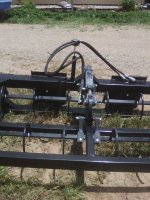powerscol
Veteran Member
If you can push the mail end in and or simply pull it out without ever pulling on the collars, does that work for you?
These female couplers have a 2 way sleeve as earlier described. With the sleeve held in a mount, all you do is push or pull the male end in or out.
Very very easy for coupling or uncoupling. :thumbsup:
That might work. I had to fight to get my hay grapple off. Fittings are in the center and I just cold not get a grip on one of them. Pushing in on the coupler while pulling the mail out was a bit rough. Question - the hoses on my hay grapple do sometimes get a slight strain on them when gathering hay. I have a big spring holding the hoses out of the way, but at full tilt down it gets compressed. The breakaway couplings would not pull loose would they? Ill get some pictures of my set up.
Thanks - Keith


